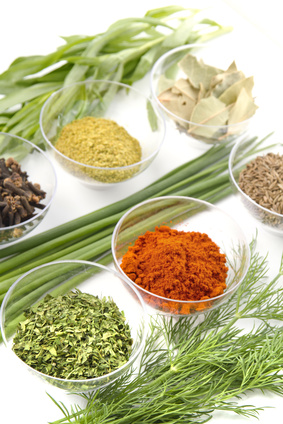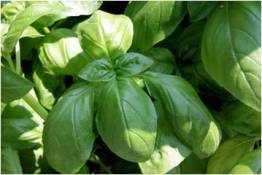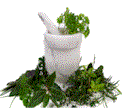Guide to Fresh Culinary Herbs
Cooking with fresh herbs is a surprisingly easy way to make a strong and interesting statement on your next party menu

Tarragon, cloves, ground mustard, bay leaves, chives, basil, cayenne, fennel seeds, dill

Beautiful Basil Leaves

Sage, thyme, chives and rosemary
Fresh herbs will give your dishes a distinctive aliveness. They will add a sunny and perfumed character as well as color and a professional finish.
Even if you don't use fresh herbs in your everyday cooking, indulge the taste buds of your party guests.
Herbs and spices are the greatest joy to use--nature's gift to cooks.
Herbs vs. Spices
In most of the culinary world, the terms "herbs" and "spices" are used interchangeably.
Specifically, herbs are the fragrant, oil rich leaves of the particular plant and spices are the bark, fruit, root or seeds of the particular plant
- Fresh herbs are best used in the last few moments of cooking as lengthy exposure to heat will weaken their delicate bouquet. They shouldn't cook in liquids for more than a half-hour
- To substitute fresh herbs for dried herbs in a recipe use the general ratio of 3 to 1. That is, use 3 times as much fresh herbs as dried herbs
- Start by using small amounts and tasting before adding more. Herbs for cooking should enhance not overpower food flavors
- Some herbs have a dominant punch, like rosemary and sage and can be used alone or in combination with milder herbs
- Milder herbs can be blended into many delightful flavor combinations
Experiment and enjoy!
- Fresh herbs are a quick and easy way to enhance the flavor of a finished dish as well
- Use
the same herb (if used) the food was cooked with, chop and sprinkle on
appetizers, casseroles, meat courses or vegetable dishes
- Beware of rosemary and sage. They are quite fragrant but may quickly overpower other flavors and the chopped leaves of these herbs are not pleasant to bite into
- Herbs with soft leaves are the best for sprinkling such as basil, parsley, cilantro, thyme and chives. They are fresh tasting and will compliment bold or mild flavors
- Do not chop herbs until right before use otherwise their fragrant oils will evaporate or they will change colors
- Use a very sharp knife and make sure they are dry as they will be harder to chop when wet
Herbs de Provence or Herbes de Provence is a versatile and savory spice blend. Purchased versions use dried herbs. Here is my adaptation using fresh herbs. Delicious on hot carrots, corn, salads, beans, baked chicken, roasted lamb and seared rib-eye steak. Also use in meat or vegetable soups and stews.
Herbs de Provence Recipe
Blend 1/4 cup each of chopped fresh thyme, oregano, marjoram and savory. Add 1 1/2 tablespoons of minced fresh rosemary, 1 teaspoon of fennel seeds and 1 teaspoon of dried lavender buds.
Dried lavender buds are one of the distinguishing tastes of Herbes de Provence. They may be hard to find but try gourmet herb markets or health food stores. Make sure they are food grade. If not found just omit.
Storing Fresh Herbs
Fresh herbs are expensive and it is always practical to store them properly to preserve as much freshness and flavor as possible.
If you buy herbs in the plastic cartons from the supermarket you will usually have more than you need for one recipe. After a day or two the herbs will began to wither and spoil. It is best to use them in other dishes you may cook to enjoy maximum flavor while it lasts.
Place soft leafy herbs like oregano, cilantro and parsley, stems down, in a small container of water with leaves loosely covered with plastic wrap. Store on the warmest shelf of your refrigerator.
Basil may be left at room temperature by placing stems in a container with a small amount of water. I have had basil last a little longer by changing the water every day (as you might do with fresh flowers).
Drying Herbs
Air drying is a great way to preserve the delicate oils and flavor of your fresh herbs. The easiest way to air dry store-bought herbs is to remove the leaves and lay them out in a single layer on a plate or baking sheet.
Loosely cover with dry paper towels. It may take up to a week to thoroughly dry. Store herbs in glass jars or containers on the pantry shelf.
I find that herbs like oregano, thyme and rosemary will gently dry in the original container, in the refrigerator, without developing an unwanted mold or film. Remove the dried leaves and store in glass containers in the refrigerator or in a dry pantry
The general rule of thumb is to air-dry low-moisture herbs like rosemary, thyme, savory and dill, and freeze moist herbs such as basil, mint, chives, oregano and tarragon

Freezing Herbs
Remove the leaves from herbs like basil, cilantro, oregano, sage and parsley and place them on a large plate or baking sheet. Keep the leaves as separate and individual as possible. Place the plate in the freezer. Once the herbs are frozen, loosely place them in a zip lock bag.
Place the bags in a larger plastic bag and keep the bag as flat as possible in the freezer.
No need to thaw, just sprinkle over hot vegetables, in sauces and in braises. There will of course be a loss in flavor and appearance.
Another freezing method is to coarsely chop your herbs. Place the chopped herbs into small ice cube tray compartments. Fill each compartment with water and freeze.
Pop the "herb cubes" out of the tray and store in freezer safe plastic bags. There is no need to thaw the cubes. Just toss into sauces, stews or soups.
Check It Out
You can also use olive oil in place of the water to freeze herbs. Believe it or not, olive oil will freeze at 10ºF. Not all olive oils will freeze due to the chemical variants of olive oil, with each variant having its own freezing point. You will need to experiment with your favorite brands.

In case you were wondering:
SALT
Salt is neither an herb nor a spice - but IS the number one seasoning in all the world. Actually an "innovation" of mankind and noted throughout history. The most common forms include:
Table
From mined rock salt deposits, contains chemical additives to keep it free-flowing. Added iodine causes a slightly bitter aftertaste. Has the "saltiest" taste.
Kosher
Also mined from rock salt but with no additives. Purer taste, course grain, dissolves more quickly then table salt. Preferred by most chefs
Sea Salt
Made by evaporating sea water. No additives, clean taste, course, large grains. Takes a little longer to dissolve and better for longer cooking periods, as for soups and stews.
Fleur de sel
French for "flower of salt". Harvested by hand from salt beds. It has a delicate flavor and works well as a finishing touch to appetizers, salads and roasted meats.
Comments
Have your say about what you just read! Leave me a comment in the box below.